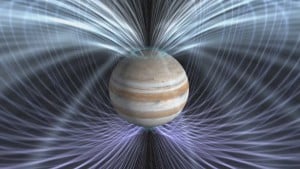
 NASAs Juno spacecraft will make its long anticipated arrival at Jupiter on July 4. Coming face-to-face with the gas giant, Juno will begin to unravel some of the greatest mysteries surrounding our solar system’s largest planet, including the origin of its massive magnetosphere.
NASAs Juno spacecraft will make its long anticipated arrival at Jupiter on July 4. Coming face-to-face with the gas giant, Juno will begin to unravel some of the greatest mysteries surrounding our solar system’s largest planet, including the origin of its massive magnetosphere.
Magnetospheres are the result of a collision between a planet’s own magnetic field and the supersonic solar wind. Jupiter’s magnetosphere—the volume carved out in the solar wind where the planet’s magnetic field dominates—extends some 2 million miles outward from the planet’s surface.
In order to look inside the planet, the science team equipped Juno with a pair of magnetometers. The magnetometers, which were designed and built by an in-house team of scientists and engineers at NASA’s Goddard Space Flight Center in Greenbelt, Maryland, will allow scientists to map Jupiter’s magnetic field with high accuracy and observe variations in the field over time.
“The best way to think of a magnetometer is like a compass,” said Jack Connerney, deputy principal investigator and head of the magnetometer team at Goddard. “Compasses record the direction of a magnetic field. But magnetometers expand on that capability and record both the direction and magnitude of the magnetic field.”NASA’
The magnetometer sensors rest on a boom attached to one of the solar arrays, placing them about 40 feet from the body of the spacecraft. This helps ensure that the rest of the spacecraft does not interfere with the magnetometer.
However, the sensor orientation changes in time with the mechanical distortion of the solar array and boom resulting from the extremely cold temperatures of deep space. This distortion would limit the accuracy of the magnetometer measurements if not measured.
To ensure that the magnetometers retain their high accuracy, the team paired the instruments with a set of four cameras. These cameras measure the distortion of the magnetometer sensors in reference to the stars to determine their orientation.
“This is our first opportunity to do very precise, high-accuracy mapping of the magnetic field of another planet,” Connerney said. “We are going to be able to explore the entire three-dimensional space around Jupiter, wrapping Jupiter in a dense net of magnetic field observations completely covering the sphere.”
One of the mysteries the team hopes to answer is how Jupiter’s magnetic field is generated. Scientists expect to find similarities between Jupiter’s magnetic field and that of Earth.
Magnetic fields are produced by what are known as dynamos—convective motion of electrically conducting fluid inside planets. As a planet rotates, the electrically susceptible liquid swirls around and drives electric currents, inducing a magnetic field. Earth’s magnetic field is generated by liquid iron in the planet’s core.
“But with Jupiter, we don’t know what material is producing the planet’s magnetic field,” said Jared Espley, Juno program scientist for NASA Headquarters, Washington. “What material is present and how deep down it lies is one of the questions Juno is designed to answer.”
The observations made by Juno’s magnetometers will also add to our understanding of Earth’s dynamo, the source of our planet’s magnetic field, which lies deep beneath a magnetized layer of rocks and iron—which interferes with measurements of magnetism under the crust.
“One of the reasons that the Juno mission is so exciting is because we can map Jupiter’s magnetic field without having to look through crustal magnetic fields,” Connerney said. “Jupiter has a gaseous envelope about it made of hydrogen and helium that gives us a clear and unobstructed view of the dynamo.”
Editor’s Note – CulverCityCrossroads.com has been granted a press pass for Juno’s connection to Jupiter on Monday, July 4, and we will be reporting from JPL in Pasadena.


Be the first to comment